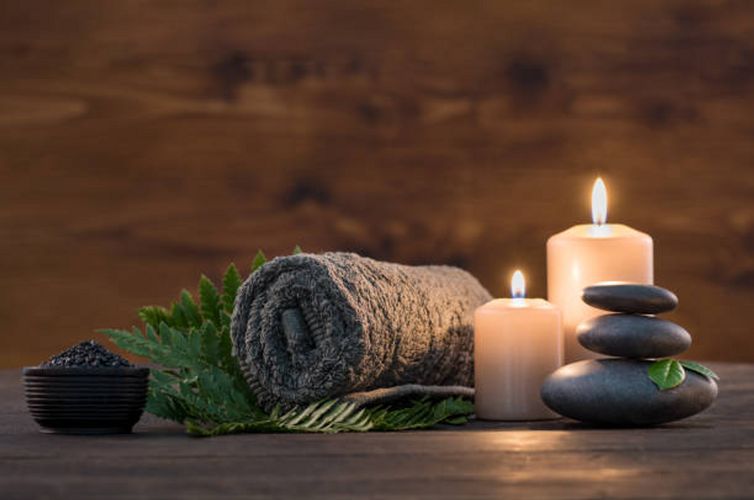Delayed-Onset Muscle Soreness (DOMS).
This is the same official name of post-workout muscle soreness. You feel fine after working out, but you wake up the next morning and BAM, it all hits you!
While some soreness is normal (similar to a moderate to intense workout), post-massage soreness or cramping shouldn't restrict your daily activities, nor persist past a few days. If it does, there might be something else going on.
Here's a quick list of the top causes of muscle soreness post-massage that I encounter in my massage clients:
1. Lack of hydration
You know how most massage therapists will present you with a glass of water after your massage? We're all secretly hoping you drink more than that!
Sometimes I will even pause a massage and tell the client I am getting them a glass of water for them to drink because their body is getting red and inflamed even from a few minutes of massage. Many who take me up on this offer notice that their redness fades and their muscles release significant tension within minutes, even in areas I haven't massaged yet.
How does this happen so fast? While it takes a few hours for consumed water to travel all the way to the involved tissues, our bodies are intelligent and hoard water when there isn't enough to go around. Upon drinking more water, our bodies seem to recognize that there isn't a drought and releases water to the auxilary tissues (such as tense muscles) in anticipation of receiving more water.
There are many, many opinions out there on how much water a body needs each day, but my preferred formula for most healthy people is a minimum of 2/3 ounces of water per pound of body weight per day, with no more than 32oz above that. In other words...
Your Body Weight (in lbs) x 2/3 = Minimum H2O/day (in oz)
Min H2O/day (in oz) + 32oz = Maximum H2O/day (in oz)
Remember to take thse guidelines with a grain of salt (literally!) and don't consume this much water if you're on a salt-restricted diet! Talk to your doctor about how much water to drink each day, especially if you have known cardiovascular or kidney conditions.
2. Improper Sodium/Water Intake Ratio
Many clients are told by their doctors to reduce their salt intake due to high blood pressure, cardiovascular disease, and certain types of kidney diseases. This is considered a medical diet, and should be supervised by a physician.
However, many clients who have no known health conditions hear all the press about low-sodium medical diets and start to wonder if avoiding salt is healthy even for those without these medical conditions. This is still up for debate in some healthcare communities. Just like eggs, the expert opinion on salt has changed over time. We DO know that a small amount of salt is required, but the standard American diet of processed food has an overabundance of salt.
What about individuals who eat a whole foods diet, which is naturally low in sodium? Are they at a risk of running too low in sodium? Some experts say yes, you can!
Our taste receptors can change how we perceive certain flavors when we experience an overabundance or insufficiency of nutrients in order to help guide our food choices.
Therefore, an easy way to test whether or not you might need more salt is to place 1/4 of a teaspoon of salt on the tongue. If you don't immediately spit it out due to it tasting too salty (perhaps it doesn't even have much of a taste at all!), it's possible your body needs more salt.
A good rule of thumb is to salt your food until you can taste that it is slightly saltier, and then stop.
Remember that our bodies like to maintain a consistent salt/water ratio, so if we don't drink enough water, our body won't want as much salt (and therefore it could taste saltier). An overabundance of water without adequate salt consumption can lead to a bloated, "waterlogged" feeling, while an overabundance of salt without adequate water consumption can present with dry mouth, thirst, and oversensitivity to salty tastes.
[Regarding special types of salt: regular table salt is often sufficient for those who consume enough minerals elsewhere in their diet, but other types, such as Himalayan and sea salt contain additional trace minerals that can help cover any dietary gaps that might exist.]
3. Insufficient Mineral Intake
Our muscles require minerals in the form of electrolytes in order to relax and contract appropriately. When a tense muscle is unresponsive to touch, like a rock, I immediately ask my clients about their mineral intake.
In my practice, I find that the most commonly neglected minerals (aside from table salt) are calcium and magnesium. While it's possible to consume enough of these minerals through diet alone, it can be difficult without guidance, and most of my massage clients prefer to take a simple supplement.
Thankfully, these minerals often come in a combo supplement, often abbreviated as a "Cal/Mg" supplement. The recommended guidelines for how much calcium is necessary varies depending on age, activity level, and dietary intake, but a great goal to shoot for in cases of muscle soreness is obtaining 1200mg/day of calcium from all sources (both food and/or supplemented).
[Occasionally, I find that some clients seem to consume enough minerals, but their muscles still feel mineral-depleted. That's outside the scope of a massage session, but it's a hint that there's likely a problem with digestion or metabolism of minerals (such as insufficient stomach acid) and requires a little more digging to determine the root cause.]
4. Medication Side Effects & Unmanaged Health Conditions
Have you ever read the list of side effects that comes with a medication? Muscle soreness can be one of them!
This is especially common in statin medications, which are commonly used to lower cholesterol in the hopes of treating or preventing cardiovascular diseases. When they were first developed, researchers noted that statin medications depleted the body's naturally occurring CoQ10 (required for cellular energy production), and therefore, a small amount of CoQ10 was included in the statin pill in order to offset the effects of this depletion.
This was practice was later abandoned, and now recent research suggests that CoQ10 depletion could be responsible for statin-induced muscle pain.
Supplementing CoQ10 with a statin might not help in all cases, but it's one example of a simple, low-risk intervention that could prevent muscle soreness due to a medication side effect.
Diuretics
On the flip side, sometimes I encounter clients who have health conditions that are not properly managed under the care of a physician. Because it is considered a low-force, all-natural modality, massage can attract the sort of clientele who is philosophically opposed to Western medicine and prefers to seek treatment elsewhere.
5. Lack of Communication between You and Your Massage Therapist
Maybe you didn't realize that you booked a deep pressure therapist, and they neglected to ask your preferred pressure. Maybe you considered the massage therapist the expert and didn't want to get in their way. Regardless of the cause, this is an alarmingly common cause of excessive muscle soreness!
As massage therapists, we're always on the lookout for nonverbal cues that our pressure is too heavy (flinching, muscle guarding, breath-holding, sharp inhales, etc), but many clients also repress these!
I also find many clients attempt to minimize their discomfort under the belief that massage is "no pain no gain" and they need to "suck it up" in order to gain maximal benefit. This is not true!
While some discomfort can be expected during a treatment-focused massage, you should still be able to breathe at a normal rate and rhythm without tensing your muscles on every massage stroke.
Some clients also repress their discomfort because they DO prefer a deeper massage and are concerned that their massage therapist will overcompensate if they speak up, giving the client a lighter massage than desired. This is a common rookie mistake in the massage world, and new massage therapists often encounter this as they learn how to fine-tune their pressure.
I still encourage clients to speak up on both counts: tell your therapist the pressure is too heavy, and then if they change their pressure to too light, tell them it's too light! I understand that you don't want to seem too needy, but we massage therapists really do appreciate the communication. We want to give you the best massage possible, and we can't do that without your help.
References
Choy, M. C., ND, LAc, & Millet, K. S., DC. (2015, May 22). TBM Brief: Calcium. Retrieved July 31, 2019, from https://www.livetbm.com/pdf/TBM_Brief_-_Calcium.pdf
Institute of Medicine (US) Committee to Review Dietary Reference Intakes for Vitamin D and Calcium; Ross AC, Taylor CL, Yaktine AL, et al., editors. Dietary Reference Intakes for Calcium and Vitamin D. Washington (DC): National Academies Press (US); 2011. 5, Dietary Reference Intakes for Adequacy: Calcium and Vitamin D. Available from: https://www.ncbi.nlm.nih.gov/books/NBK56056/
Millet, K. S., DC, & Choy, M. C., ND, LAc. (2018). TBM Module 1 Manual(40th Anniversary ed.). Henderson, NV: Total Body Modification.













